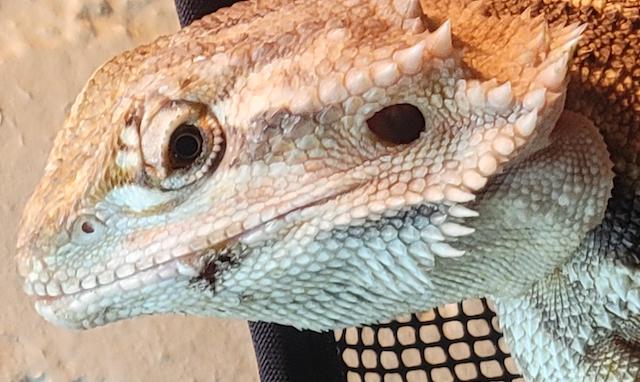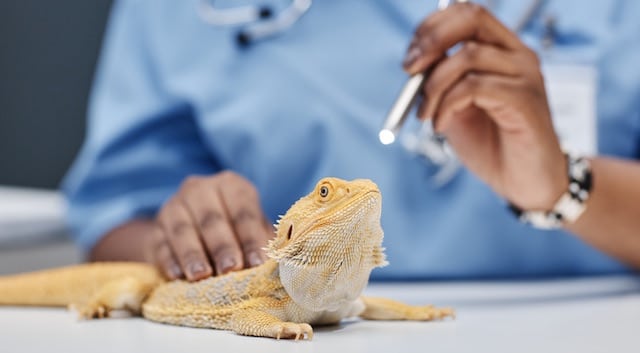
What is Bearded Dragon Mouth Rot?
Mouth rot is a common infection in bearded dragons that can seriously impact their health. This painful condition is medically known as infectious stomatitis and requires immediate veterinary attention. The infection typically starts around a bearded dragon’s mouth and gums but can quickly spread to other parts of their bodies if left untreated.
Although mouth rot is easy to treat in the early stages, it’s important to understand how this condition affects bearded dragons and how it can be successfully treated and prevented.
Understanding Bearded Dragon Mouth Rot
Mouth rot is a necro-inflammatory condition that attacks the soft tissue of a bearded dragon’s mouth. It causes painful lesions and inflammation that can prevent bearded dragons from eating and drinking properly.
Most cases of mouth rot occur in reptiles secondary to fungal and bacterial infections. This is because reptiles have a specific tooth structure where their teeth are fused close to their jawline, known as “acrodont dentition.” This delicate structure can easily be injured from small cuts in their gums or food stuck in their teeth, leading to secondary infections.
Stress, poor diet, improper environmental conditions, and bad dental hygiene are the main factors that cause mouth rot in bearded dragons. These factors weaken a bearded dragon’s immune system, making them more susceptible to infections. The bacteria that cause mouth rot flourish in dirty enclosures or contaminated food and water.
Various fungi and gram-negative bacteria are primarily responsible for this condition, including:
- Mycobacterium
- Pseudomonas
- Aeromonas
- Klebsiella
- Salmonella
- Aspergillus
Signs and Symptoms of Bearded Dragon Mouth Rot
Here are the main physical signs of mouth rot in bearded dragons:
- Lesions and discoloration in or around the mouth and gums
- Inflamed, swollen mouth
- Facial discharge and bleeding
- Foul smell
- Loose, rotten teeth
Lesions, swelling, and discharge are the most noticeable symptoms of this infection. Mouth rot can also result in various behavioral changes like loss of appetite, lethargy, and open-mouth breeding. These symptoms get worse as the infection progresses and can become fatal without prompt treatment.
Open-mouth breathing is a concerning symptom that occurs when the facial swelling is severe enough to make it difficult for them to close their mouth or breathe normally. Furthermore, this condition can become so painful that bearded dragons will stop eating and drinking entirely because they cannot move their jaws.

Diagnosing Bearded Dragon Mouth Rot
If your bearded dragon is showing signs of mouth rot, it’s important to take them to an exotic veterinarian right away.
An exotic veterinarian will diagnose your bearded dragon based on the symptoms and the results from diagnostic tests. The first step would be physically examining your reptile and identifying early signs of mouth rot. They might decide to do a swab culture or biopsy on the infected tissue to determine the specific bacterial or fungal organisms responsible for the infection. In some cases, an x-ray is necessary to see if the jaws are infected, which usually requires additional treatment.
Bearded Dragon Mouth Rot Treatment Options
Treatment for this condition can vary depending on the severity. Sometimes, multiple treatment options are needed to ensure bearded dragons make a successful recovery. In severe cases, bearded dragons might need a feeding tube to assist them with eating and drinking.
Antibiotic Therapy
Broad-spectrum antibiotics are the best way to treat moderate to severe infections, especially if they progress to the bone. Although mouth rot infections start in the gums, they can spread to the tongue, jaws, and teeth, too. Antibiotics help to kill the bacteria causing the infection and prevent the infection from spreading further. Both topical and oral antibiotics can be used, such as Baytril and povidone-iodine.
Antibiotic therapy typically lasts 7 to 10 days and should never be stopped earlier than the veterinarian recommends, even if your bearded dragon’s symptoms have subsided.
Antifungal and Anti-inflammatory Medications
If a fungal organism is responsible for the infection, the veterinarian will prescribe an antifungal ointment to apply to the affected area. This is rare because mouth rot is usually caused by bacteria.
Anti-inflammatory medications can help relieve pain and inflammation in mild cases. However, opioids may be needed in severe cases to control pain and to keep bearded dragons comfortable as they recover.
Surgical Intervention
If the mouth rot infection is severe or other treatment options aren’t working, an exotic veterinarian might recommend surgery. This is done in an effort to keep the infection under control by surgically removing infected flesh, teeth, or dead tissue. Your bearded dragon will be given pain medication and antibiotics to aid their recovery and prevent the surgical wounds from becoming infected.
Home Care and Nursing
Bearded dragons should be kept comfortable as they recover from mouth rot, so a few lifestyle changes are necessary.
It’s crucial to keep their enclosure clean because a dirty environment can hinder the healing process and expose the wounds to harmful bacteria. Use reptile-safe disinfectant to regularly clean their enclosure, food and water bowls, and flat surfaces. Remove any hard or sharp substrate from the enclosure that could potentially stick to their wounds or cause further irritation. The wounds should be kept clean by gently washing the area with medicated solutions, usually once or twice a day.
You are also responsible for administrating medication to your bearded dragon as directed by an exotic veterinarian. It’s better to apply topical medications with disposable surgical gloves rather than your bare hands to avoid spreading bacteria to the wounds.
Nutritional Support During Treatment
Bearded dragons need a nutritious diet containing soft-bodied insects and vegetables during recovery. They might have difficulty eating certain foods because their mouths and gums will be swollen and painful.
Foods like sweet potato, pumpkin, and leafy greens are great because they are soft and easy to chew. Plus, they are high in fiber and tasty, which encourages a healthy appetite. You can offer dubia roaches and crickets as a source of protein. The insects should be dusted with calcium and vitamin D3 supplements to support healthy bones. Protein, calcium, and vitamin D3 are essential for successful wound healing and can help speed up the recovery process.
If your bearded dragon is in too much pain to eat, an exotic veterinarian might recommend feeding a liquid diet until they are better. You might need to give them water with a syringe or eye dropper if they have difficulty drinking by themselves.
Monitoring Progress and Follow-Up Care
It can take up to two weeks for bearded dragons to recover from mouth rot after treatment. This is usually longer if the infection was severe or required surgery. It’s important to closely monitor your bearded dragon during recovery and inform the veterinarian about any changes.
Increased appetite and activity levels are some of the first signs of improvement. You will gradually notice how your bearded dragon behavior returns to normal because they are no longer in pain from the infection.
It’s not a bad sign if your bearded dragon’s health seems to be getting worse after treatment. If they continue to act lethargic, refuse food, or have difficulty moving, you should take them to an exotic veterinarian for a follow-up appointment. This could indicate that the medication isn’t working properly, or perhaps their diet or environment is interfering with a proper recovery.
Preventing Mouth Rot in Bearded Dragons
- Maintaining a hygienic environment: A dirty environment can expose your bearded dragon to various infection-causing bacteria and fungi. The enclosure should be deep cleaned a few times a month and spot-cleaned daily to maintain a hygienic environment. Regularly disinfect different surfaces in the enclosure, replace soiled substrates, and wash their food and water bowls thoroughly.
- A healthy diet: Feed your bearded dragon a balanced, varied diet suitable for their life stage. A healthy diet helps to strengthen their immune system so that they can ward off infections. Feeding hard-bodied insects like cockroaches and locusts can help to keep their teeth clean and strengthen the gums.
- Regular veterinary check-ups: Yearly health examinations are beneficial for detecting potential health issues early on for a more effective treatment. Your bearded dragon will also be examined for any injuries that need to be treated to prevent possible infection.
Conclusion
Mouth rot is a painful condition in bearded dragons that is easy to treat with early detection. It can cause various physical and behavioral changes that negatively impact a bearded dragon’s quality of life.
Most bearded dragons can successfully recover from mouth rot with proper treatment, which involves medication and certain dietary and lifestyle changes. Look out for signs of this infection and take them to an exotic veterinarian when necessary. Proper care, a healthy diet, and regular health checks are the best ways to protect them against this condition.



